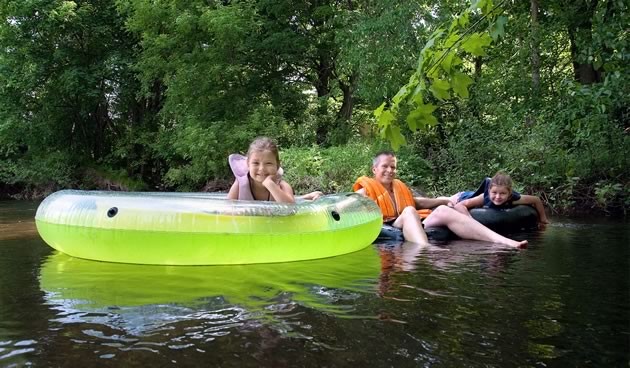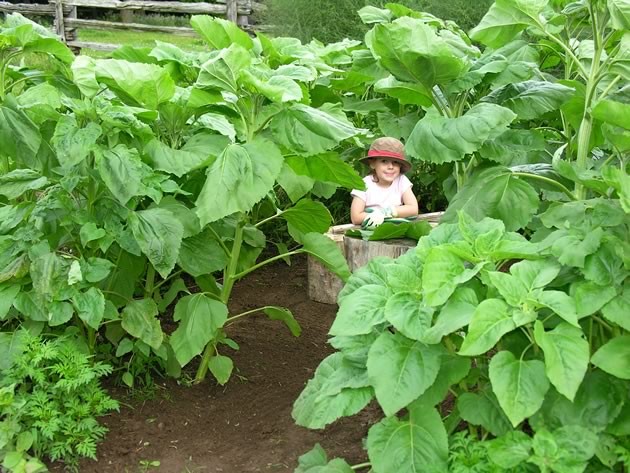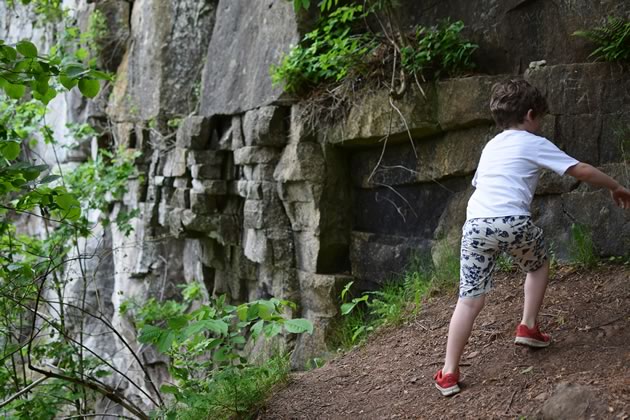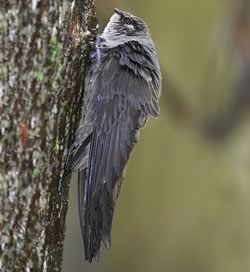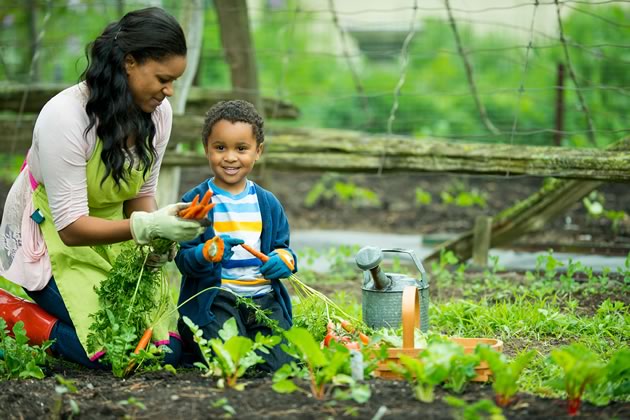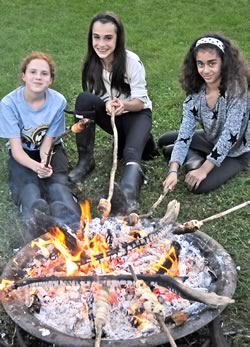Get the Kids Outside!
The Nature Fix: 12 ways to get the kids outside this summer and unleash your own inner kid.
1. Ride a River
Go tubing in Inglewood
Times may have changed, but one thing remains constant in the Caledon village of Inglewood during the summer: older kids and adults carrying inner tubes down the main drag for a float on the river.
On McLaughlin Road, at the south end of the village, there’s a small parking lot on the banks of the Credit River. Slip in there (don’t forget a life jacket!) or at other spots farther east, and float for a few minutes or spend a few hours being carried all the way to Cheltenham. Be sure to arrange to be picked up by a friend or family member there. The water is shallow and there may be small portages to traverse when the water level is too low.
While the Credit Valley Conservation Authority does not endorse paddling or floating down the river, it has pulled together a guide to river access points, along with a list of specific warnings and hazards to watch for.
See creditvalleyca.ca and search “navigating the Credit.”
2. Discover history in the green
In Belfountain Conservation Area
The Headwaters region is home to many idyllic parks and conservation areas, all of them great places to wander and refresh. If your young charges need a little more than nature to keep them engaged, check out the Belfountain Conservation Area for the circular trail leading to its swingy (but safe!) suspension bridge over a waterfall and Yellowstone Cave, a slightly eerie stone structure kids can duck inside. Both were built by Charles W. Mack, who invented the cushion-back rubber stamp. He purchased the property as a summer retreat in 1908 and opened it to the public a few years later. Older kids can do the loop themselves, while you kick back and relax. Read more about the park at creditvalleyca.ca. Check out the Belfountain/
forks park loop hike from Caledon Hikes: Loops & Lattes.
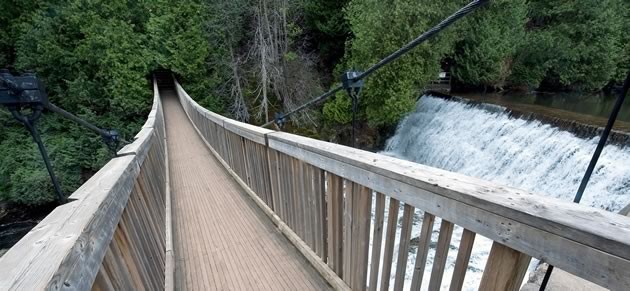
Check out the Belfountain Conservation Area for the circular trail leading to its swingy (but safe!) suspension bridge over a waterfall and Yellowstone Cave. Photo by Rosemary Hasner / Black Dog Creative Arts.
3. Plant a sunflower house
In your backyard
Do you have six square feet of lawn to spare? Planting a sunflower house is an activity that can literally grow to fill the summer. At first it’s a garden project, then it’s a delightful private space where the kiddos can hide away, have a tea party or, if you’re lucky, invite the grownups to visit.
First, stake out the “walls,” leaving a space for the “door.” Then dig a shallow trench around the perimeter and plant the seeds. Choose a variety that grows to more than 8 feet. For thicker, lusher walls, add a shorter variety around the outside of the interior wall. (Once they germinate, thin the seedlings as necessary to allow for growing room.)
If you like, as the taller plants reach full height, you can gently pull their tops together and fasten with sturdy string to form a “roof.”
4. Plan a magic forest picnic
On the Bruce trail
Any section of the Bruce Trail is bound to delight, but Caledon insiders have one sweet route they keep coming back to. Join the Bruce Trail at the end of Caledon Mountain Drive, south of Belfountain off Mississauga Road. Then hike down the escarpment on a railway-tie staircase to Forks of the Credit Road via Chisholm Street for a picnic by the Credit River. Along the way you’ll see magical mossy boulders, a dense sun-dappled forest and sweeping views across the Credit River valley. The hike back up will be steep – so you’ll be thankful for good hiking shoes.
For a much longer hike (two to three hours over 8.5 kilometres) suitable for adults and older kids, check out the Belfountain/Judy Charbonneau loop in Nicola Ross’s new book Caledon Hikes: Loops & Lattes.
5. Dip into a pond
Any pond or river
Yes, by all means go for a swim. But if you have access to a pond, a little marine biology is a fine way to while away an afternoon. You’ll need nets, light-coloured containers (a white basin would fit the bill) and a magnifying glass. Ponds swarm with cool critters.
Children can dip from the side of the pond. Or, with their parents’ blessing, the more adventurous can wade into the pond, get wet and muddy, and have a ton of fun. Check out some online resources (search “pond creatures”) to help identify the frogs, insects and minnows you find. And don’t forget to put them back!
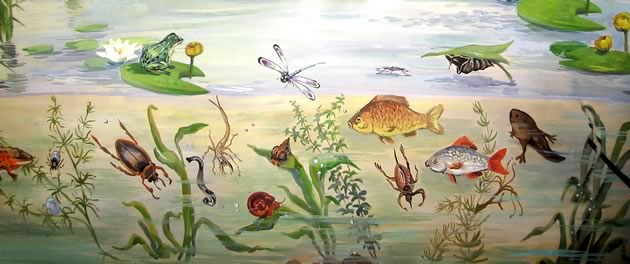
If you have access to a pond, dip in, a little marine biology is a fine way to while away an afternoon.
6. Read under a tree
In your backyard, parks and conservation areas
Nothing beats a gripping summer read – make that reads, if you tap into a series such as Nancy Drew or Harry Potter. While it may seem like a decadent way to spend an afternoon, especially if undertaken in a hammock, reading has also been shown to stem the summer learning loss that affects many kids, according to research.
Public libraries are working to help. The Orangeville Public library, for one, offers a weekly “Ready, Set, Read!” program for kids in Grades 1 to 3, and participates in the TD Summer Reading Club, which is a good source of ideas for parents to support kids in choosing their summer reads.
We think combining a book with a blanket and a glass of lemonade is a great way to get going!
See orangeville.ca/orangeville-public-library and tdsummerreadingclub.ca.
7. Take a stroller-friendly meander
In the Terra Cotta conservation area
Need a flat, short walk that works for toddlers and preschoolers, but also for the baby who needs her stroller? Try the Terra Cotta Conservation Area’s easy 2.2-kilometre hike around Wolf Lake. Pack a picnic or add a visit to the nearby wetlands to round out the day. Insider tip: this is where Conservation employees like to come for their staff picnics!
Find a map of the trail, called Terra Cotta Lane, at creditvalleyca.ca.

Take a stroller-friendly meander in the Terra Cotta Conservation Area. Photo courtesy Credit Valley Conservation.
8. Become a caterpillar expert
in your backyard
Make this the summer of the caterpillar – and the moths and butterflies they become.
First, if you can, plant caterpillar-friendly gardens known to attract particular species: pussytoes or pearly everlasting for American ladies, milkweed (common, butterfly or swamp) for monarchs, hops and elm for the delightfully named question marks (shown above) and commas, rue for giant swallowtails, cherry for tiger swallowtails, and nettle for red admirals. (Caution: nettle stings, so plant in a pot in an out-of-the-way corner and don’t let it go to seed.)
When you find caterpillars, build one or more of them a home so you can observe them. You’ll need a cheap plastic terrarium (available in various sizes from pet stores) and a small, lidded container filled with water.
It’s best to find a caterpillar eating, so you can identify its favoured food. Punch a small hole in the container, insert a stem of the food plant and place the caterpillar on the cutting. Replace wilted or eaten food as necessary, cutting from the same plant variety. (Caterpillars shed their skins a few times as they grow.)
Most caterpillars will form pupae – cocoons (moths) or chrysalises (butterflies) – within two weeks or so, though some larger moth caterpillars take longer. Watch carefully for the emergence of the moth or the butterfly. This usually happens in about two weeks. But later in the summer a pupa may “choose” to overwinter. In this case, put it outside and let nature take its course. Or put the terrarium outdoors in a sheltered location (where it won’t fill with water). Come May, check it daily or bring it inside and watch the wonder of metamorphosis.

First, if you can, plant caterpillar-friendly gardens known to attract particular species. Hops and elm for question marks.
9. Look for chimney swifts
in your backyard, parks and conservation areas
Consider this birdwatching with a purpose for older, nature-conscious kids and teens. Chimney swifts were named for their fondness for nesting in chimneys. Brown all over, their closest living relatives are actually hummingbirds.
Chimney swifts are suffering alarming declines. So the nonprofit Bird Studies Canada is co-ordinating SwiftWatch to survey swifts and monitor their nesting and roosting sites in towns and villages. They eagerly seek swift observers.
Says our nature writer Don Scallen, “When I was researching my swift/swallow article (“Swifts and Swallows,” spring ’14), I found swifts flitting over Orangeville and Bolton. They are also found in Erin, Cataract and undoubtedly other places in the Headwaters. “
For more information, check out “swifts and swallows” at birdscanada.org.
10. Grow your snacks
in your backyard or a community garden
If you have room for a small plot or a few containers, enlist the kids as mini-gardeners. Start with some of the easier crops such as zucchini, cherry tomatoes, herbs and lettuces, and watch them sprout, bloom, grow – and get plucked and, with luck, eaten for dinner.
Don’t have a ton of space? Sign up for a plot in a community garden such as the nonprofit Albion Hills Community Farm near Palgrave, and make vegetable growing an ongoing activity throughout the summer.
Rental prices at Albion Hills start at $35 for a 200 square-foot plot. You’ll be tending your garden next to the pros who run a Community Supported Agriculture (CSA) program out of the farm, so there may be great veggie-growing tips to glean.
See albionhillscommunityfarm.org for availability.
11. Make a fairy garden
hunt for miniature delights
While you plant kale and deadhead your geraniums, set your kids up with a gardening project shrunk down to their size. Fairy gardens are miniature landscapes decked out with Lilliputian lawns, flower gardens, seats and other necessities.
Garden centres carry all sorts of accessories for this popular pastime, but it’s fun to explore yards and woods for your own pretty stones, mosses, acorns, pine cones, twigs, bark and other natural building materials – searching for them is half the pleasure. Take a gallop through a few Pinterest sites for inspiration, then go on a scavenger hunt for your own supplies.
Fairy garden ideas we love:
- thimbles for flower pots
- a small clay pot on its side, carpeted in moss, pine cones and boughs as a home
- glass jars and tea cups made into fairy terrariums
- a tiered “fountain” made of sea shells
No word on how to get the fairies to move in, but we’re sure they will.
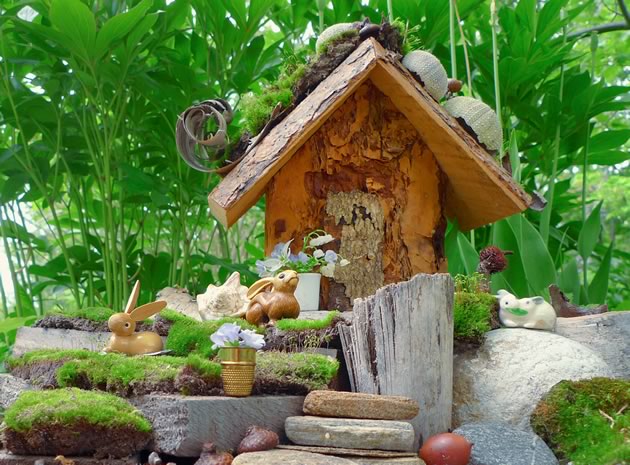
It’s fun to explore yards and woods for your own pretty stones, mosses, acorns, pine cones, twigs, bark and other natural building materials. Photo by Signe Ball.
12. Have a cookout
make bannock and ‘bake’ it yourself
Nothing says summer in Canada quite like a campfire. At the Mansfield Outdoor Centre, summer camp director Drew Gulyas says that prepping and cooking on an open fire gets kids working hard and achieving goals too. He recommends making this easy bannock for an outdoorsy treat. “Nothing tastes better,” he says.
(Please enjoy your fire safely, with all the required permits. And make sure it’s extinguished properly when you’re done.)
Drew’s recipe for bannock:
- Mix 3 cups of flour together with ½ cup sugar and
2 tablespoons baking powder.
Once mixed, add 2 tablespoons vegetable oil or margarine and blend completely with the dry mixture until it’s crumbly in your fingers. - Now take 2⁄3 cup water and add it slowly to the dry mixture until it’s the consistency of play dough.
- Take a hunk of the dough the size of a large plum and roll it in your hands until you’ve got a 12-inch-long “snake” with a diameter no larger than your index finger.
- Using a stick as long as your leg and with a diameter of about two fingers, coil the dough snake around the stick so that it covers the first 6 inches.
- Now hold it over the hot coals, turning slowly and constantly so it doesn’t burn. You’ll know it’s done when the bannock is golden brown.
- Slather on some butter or jam while you’re waiting for it to cool. Then eat it right off the stick!
We’d love to hear how you inspire a love of the great outdoors with the kids in your life! What are your favourite childhood memories of summers in the hills? Please leave us ideas in the comments at the bottom, or share with us on Twitter @inthehillsmag and Facebook, facebook.com/inthehills. With thanks to this magazine’s regular nature writer Don Scallen, who contributed the items for raising caterpillars, counting chimney swifts, and pond dipping.

